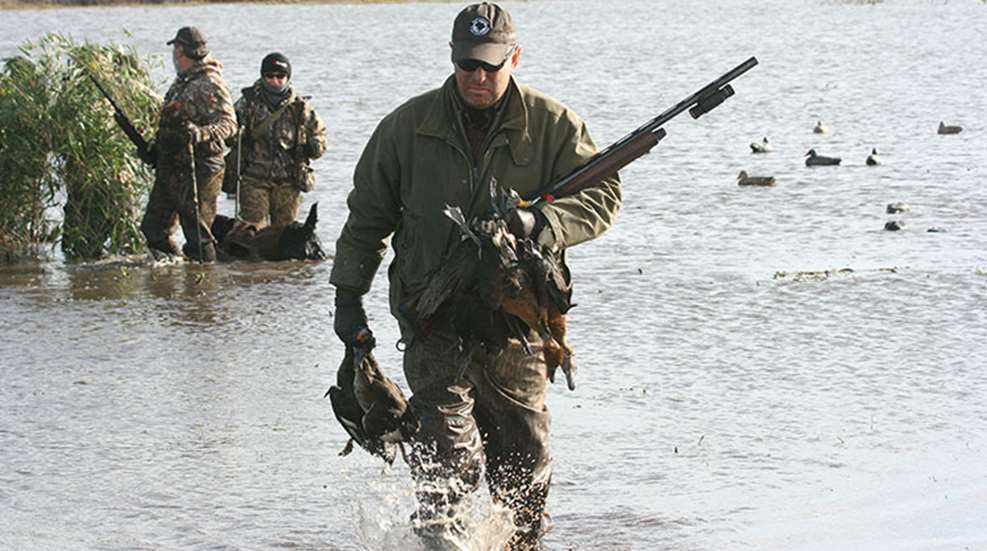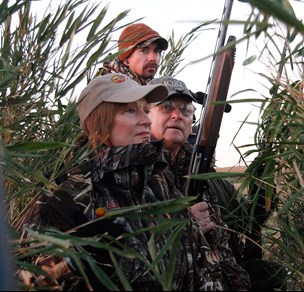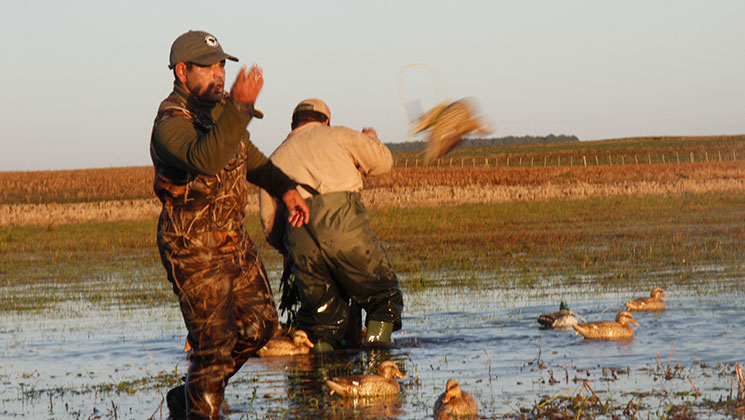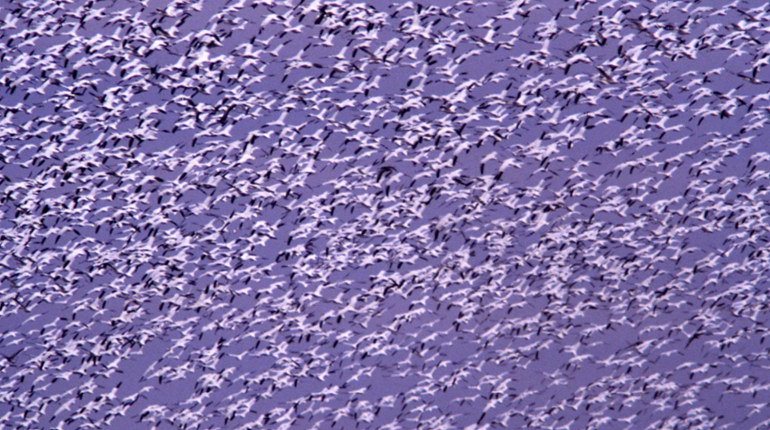
For some it’s the heart-hammering kaaaaaaa! of a longbeard in a hardwood hollow. I’ve seen good ol’ boys moved to poetry when a wild covey of quail explodes over birddogs posed as if painted in time. Maybe it’s a bull elk crashing timber in snowy Montana pines, or the bawl of a favorite coonhound at bay. But music to my ears is a flight of teal, searing the fall air moments before plopping in the decoys with a telltale splish. The sound is exhilarating, regardless whether I hit one.
My affair began in my ninth year I believe, at Charlie’s watershed, just before daybreak. We’d slipped to the water’s edge, having no designs on a blind, when I heard that curious air-tearing sound overhead. At first it startled me. Then 10 green-wings rode the waves where seconds before there was only rising fog. I parted the willows with the barrel of my old Stevens and leveled it at the raft of little birds bunched like driftwood. Boom! The 20-gauge barked, and when my eyes opened two teal remained, bobbing in unison, heads down. We waited as they drifted to my feet then I picked them up and held them out for my father. He held out their wings and admired them. They’ve been my favorite ever since.
Turns out this miniature duck also does it for others. Ask 10 waterfowlers of their bucket-list bird and at least half say cinnamon teal. It’s on mine, too. After all, there’s only the green-winged, the blue-winged—which are common in most of the States—and the cinnamon of the Pacific Flyway, right? For years I thought these were the only teal. Silly American.
Fact is, another teal trifecta buzzes down south—far deeper south than any bayou will deliver you. You’ve just got to be game for an adventure. Indeed, a valid passport can unlock a whole new cast of characters—silver, ringed and speckled teal—roughly 6,000 miles away, as the duck flies. My hunt began in the willows, on a pond’s edge, just like it did so many years ago … .
■■■
 “Take ’em!” Terry barked a moment after I heard the telltale tearing sound overhead, and I’d have taken the loaner 391 down to its plug … if it had one. See, that’s another glory of hunting Uruguay—no magazine limit. We were each limited to the outfit’s six-boxes-of-shells-per-day rule, and while you might think shooting an unplugged shotgun is a huge advantage, I can say definitively that for me it isn’t. If I don’t hit a bird on the first or second shot, I’m already so helplessly behind that a belt-fed Beretta couldn’t help me.
“Take ’em!” Terry barked a moment after I heard the telltale tearing sound overhead, and I’d have taken the loaner 391 down to its plug … if it had one. See, that’s another glory of hunting Uruguay—no magazine limit. We were each limited to the outfit’s six-boxes-of-shells-per-day rule, and while you might think shooting an unplugged shotgun is a huge advantage, I can say definitively that for me it isn’t. If I don’t hit a bird on the first or second shot, I’m already so helplessly behind that a belt-fed Beretta couldn’t help me.
The pond was a shallow stock tank, red and muddy from cattle sloshing around its clay banks. It reminded me exactly of those in my native Oklahoma. It was July, or winter in Uruguay, and the teal swarmed the neighboring rice fields like mosquitoes over a cesspool before roosting on one of several ponds where we set up in the evening and waited in makeshift blinds made from cut willow limbs stuck upright in the mud.
On Terry’s call I blotted out a little bird’s beak with the bead and bent the trigger again and again and again. My blind mates opened up also, and I trusted that Nate Metcalf, the hired videographer, was catching all of it in HD. We’d waited until we were surrounded in teal and everyone was loaded and ready to spring the trap. And now, after a long journey getting here, it was my time to cover myself in glory—or at least to avoid becoming an immortal Internet idiot. Boom, boom, ba-boom, boom went the Beretta.
■■■
We’d flown to Montevideo (Uruguay’s capital city in its extreme south) via Buenos Aires and drove eight hours northeast across the entire country to its east coast on the Atlantic. Five miles to the north was the Brazilian border formed by the Jaguarão River. It’d be romantic to write that the country was untamed jungle rife with cattle-killing jaguars and caimans, but really it was flat farm country that was home to Texas-style ranch barons and their hired gauchos. With populations centered in cities like most of South America, this part of Portuguese-influenced
Uruguay harbors few people per square mile. Coca-Cola and John Deere products abound, and the people are bilingual at least, and gregarious. While I saw thousands of ducks and other bird life, I saw no other hunters—other than the cast of characters assembled in the blind.
On the left end was Ramsey Russell of getducks.com, exactly where he shouldn’t have been if it’s easier to shoot ducks there. This Mississippi broker of worldwide duck hunting adventure simply does not bore of downing birds, and I quickly grew annoyed with his wingshooting proficiency. At times it seemed he was showing off with his shotgun, which was exactly what he was doing now as he called his shots on the silver teal that zipped along the far bank. His empties popped me in the back of the head, which no doubt contributed to breaking my concentration on the speckled teal that crossed in front of my face like hissing jets. Boom, boom-boom, boom, ba-boom, Ramsey fired. His high-volume duck hunts are not the place for double-barrels.
On the other end of the blind was our outfitter and host, Alvaro Barcellos Souza Mouawod. (I’m not making this up.) You know the Dos Equis beer commercials that feature “the most interesting man in the world”? Evidently Dos Equis didn’t scour the Brazilian countryside, because Alvaro makes their guy look like a gel-haired dork. Sophisticated, multi-lingual, humorous and world-traveled, he’s a businessman and lobbyist for the Brazilian gun industry, a conservationist, outdoor writer, and a passionate hunter and fisherman. Of course it only figures that his lovely wife would be the world’s best non-professional chef, but what really made me envious was the way he steered his Benelli like an Italian racecar driver. Lucky for my pride, he prefers to call ducks more than shoot them—unless Terry wanted him to down a few quickly for the cameras.
This was one of those times, because Terry wanted one great flurry of teal shooting to end the day, the episode and what had been one hell of a week-long hunt, and so the Brazilian with the duck-hunting estancia in Uruguay opened up on a group of beautiful speckled teal as they zipped past. Out of the corner of my eye I saw him receive the shotgun’s recoil, as if in slow motion, before picking another bird and attempting to rid it of its wingmen. Boom, boom, boom!
And then there was Terry Denmon. Denmon’s probably in his late 60s, but he hunts ducks like teenagers do thrill rides. He owns and runs the Mojo decoy company—the spinning-wing decoys that revolutionized duck hunting—and I get the sense he strongly believes in field-testing his products again and again for quality control. All week Terry had been folding ducks like third-world newspapers and claiming them faster than the lost baggage counter at United Airlines. Although this was my first time sharing a blind with Denmon, it was obvious he thought we were old chums by the way he peppered me with put-downs if a teal didn’t tumble with each shell I cycled. This might be counter-intuitive to non-hunters, but I’d remind them that this is the way duck hunting buddies do each other, and so I felt like I was at home with him.
Terry was also the star of his own outdoor TV show, quite literally, and so he had most of the Mojo Outdoors cameras trained on him as he began shooting. True to his MO, he began banging away and then yelled, “Take ’em!” By the time I started shooting at the massive swarm of teal, Terry had reloaded and was shooting again. For this, the episode’s proverbial finale, he wanted as many dead ducks on the pond as possible—preferably floating around his Mojo decoys. Meanwhile, teal were still springing, and so all of us kept shooting. After all, you don’t go all the way to Uruguay for a six-bird limit. Boom, boom, boom, boom, ba-boom, boom-boom—we all chimed like it was the Fourth of July, which it nearly was.
■■■
Indeed, over the last four days we’d shot ducks Americans simply can’t shoot at home, both in terms of species and in numbers. There were beautiful Brazilian ducks, white-faced whistling ducks and the incredibly wary rosy-billed pochards. The rosy bills reminded me of black ducks—both in size and behavior—and they are the draw for most hunters who are not enchanted by the sound of teal. Alvaro hunts them like Phil Robertson hunts mallards. They are perhaps the wariest duck in the world, and only after many passes over the Mojos would they finally commit, if they did at all. And if they did, Terry, his girlfriend, Annette, and Ramsey would open up. I would also shoot, but most times I felt I was just wasting shells.

Keep in mind this crew was in Argentina warming up on ducks and doves a week before I arrived, and by now they were wingshooting machines. On the other hand I couldn’t even blame my shooting on the beat-up loaner Beretta, because we were all shooting beat-up loaner Berettas! And now three species of teal sliced the air, our guns blazed and the cameras rolled.
When the fusillade was over, I looked across the blind. With his shotgun’s butt on his hip, Denmon looked a little like John Wayne as he stared with his jaw set. Ramsey wore an expression of disbelief. Alvaro muttered something in Portuguese. The humming of the Mojos was the only sound I heard—indeed the only thing on the water at all. That’s right, there before us lay … not a single teal. We’d hit nothing. Nada. Nary a duck of any type anywhere in sight. Although I don’t know if it will air—because not getting any ducks is not great promotional material for getducks.com—surely Nate got the whole debacle on tape.
The truth is, we took the trifecta of teal many times over that day and certainly that week in Uruguay. But unlike that day long ago on Charlie’s watershed, this time I remember only the exhilarating sound of wings … as they sliced our pride and bee-lined yet farther south.




































